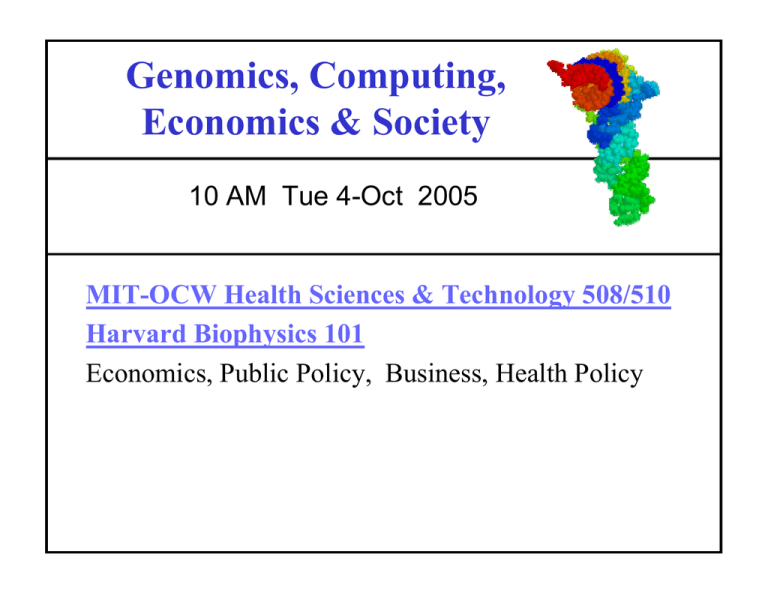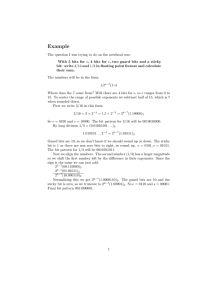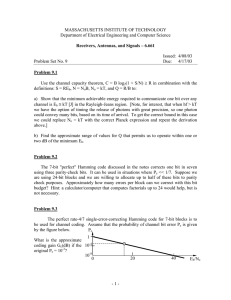Genomics, Computing, Economics & Society 10 AM Tue 4-Oct 2005
advertisement

Genomics, Computing, Economics & Society 10 AM Tue 4-Oct 2005 MIT-OCW Health Sciences & Technology 508/510 Harvard Biophysics 101 Economics, Public Policy, Business, Health Policy Class outline Photo removed due to copyright reasons. (1) Topic priorities for homework since last class (2) Quantitative exercise: bits (3) Project level presentation & discussion (4) Sub-project reports & discussion: Personalized Medicine & Energy Metabolism (5) Discuss communication/presentation tools (6) Topic priorities for homework for next class Exponent.xls 0.035 0.03 0.025 A3 =MAX(r*A2*(1-A2),0) 0.02 0.015 0.01 0.005 0 1 5 try r= 0.9, 1.01, 1.1, try y(i) =r*y(i-1) 9 13 17 21 25 29 33 37 41 45 49 53 57 61 65 1.5, 3, 3.67859, 4, 4.03 (i.e. A3=r*A2 etc.) Why the (1-A2) term? Why the MAX function? What happens when r is larger than 3? (What assumptions?) 3 Exponential technologies (synergistic) Computation & Communication (bits/sec) 1E+13 1E+11 1E+9 1E+7 operons Synthesis (daltons) 1E+5 urea 1E+3 tRNA B12 1E+1 1E-1 E.coli Analysis (bp/$) tRNA telegraph 1E-3 1830 1850 1870 1890 1910 1930 1950 1970 1990 2010 Shendure J, Mitra R, Varma C, Church GM, 2004 Nature Reviews of Genetics. Carlson 2003 ; Kurzweil 2002; Moore 1965 Figure removed due to copyright reasons. Vertebrate brain size evolution Human-chimp 1.2% Human-human 0.1% Genome: 2x 3Gbp Ongoing Adaptive Evolution of ASPM, a Brain Size Determinant in Homo sapiens Science 2005 Bond et al 2002 ASPM is a major determinant of cerebral cortical size. Nat Genet. 32(2):316-20. Jerison, Paleoneurology & the Evolution of Mind, Scientific Amer. 1976 Bits & complexity How many bits to represent your genome (from your mother)? How many additional bits for paternal DNA? How many bits to define the ribosome structure below? Figure removed due to copyright reasons. Brain complexity fig “The retina's 10 million detections per second [.02 g] ... extrapolation ... 1014 instructions per second to emulate the 1,500 gram human brain. ... thirty more years ..” (Morovec99) Figure removed due to copyright reasons. Edge & motion detection (examples) Discovering the Capacity of Human Memory Wang 2003 N=1011 neurons, m=1000 connections: n!/[m!(n-m)!] = 10^8432 bits. How Many Bytes in Human Memory? Merkle 1988 Landauer 2 bits/sec (<10^8 bits per lifetime) Inheritance is not just DNA Photos removed due to copyright reasons. Photo removed due to copyright reasons. Inheritance is not just DNA Past Locomotion 50 Ocean depth 75m Visible λ .4-.7 µ Temperature 275-370 Memory years 20 Memory bits 109 Cell therapy 0 Current 26720 km/h 10,912 m pm-Mm 3-1900oK 5000 1017 most tissues Photo removed due to copyright reasons. http://www.techworld.com/opsys/features/index.cfm?fuseaction=displayfeatures&featureid=467&page=1&pagepos=5 http://www.merkle.com/humanMemory.html THE FUTURE OF HUMAN NATURE http://www.bu.edu/pardee/events/conferences/2003/nature-program.html The Singularity Is Near : When Humans Transcend Biology The Law of Accelerating Returns by Ray Kurzweil An analysis of the history of technology shows that technological change is exponential, contrary to the common-sense "intuitive linear" view. So we won't experience 100 years of progress in the 21st century -- it will be more like 20,000 years of progress (at today's rate). .. ultra-high levels of intelligence that expand outward in the universe at the speed of light. http://www.kurzweilai.net/articles/art0134.html?printable=1 Bill Joy Wired 8.04 | Apr 2000 Our most powerful 21st-century technologies - robotics, genetic engineering, and nanotech - are threatening to make humans an endangered species. Personalized Medicine/Genetics •Haplotype Diversity across 100 Candidate Genes for Inflammation, Lipid Metabolism, and Blood Pressure Regulation in Two Populations. Crawford, et al. •A common haplotype in the complement regulatory gene factor H (HF1/CFH) predisposes individuals to age-related macular degeneration Hageman, et al. 2005 Common Disease – Common Variant Theory. How common? ApoE allele ε4 : Alzheimer’s dementia, & hypercholesterolemia 20% in humans, >97% in chimps HbS 17% & G6PD 40% in a Saudi sample CCR5∆32 : resistance to HIV 9% in caucasians SNPs & Covariance in proteins e4 20% ApoE Figure removed due to copyright reasons. Ancestral = Arg 112 Thr 61 e3 80% Energy & CO2 Sequestration Humans consume 2kW per person = 1010 kW. Sunlight hits the earth at 40,000 times that rate (70% ocean). CO2/yr: Fossil fuel use releases 5 Gton. Ocean & terrestrial productivity = ~100 Gton each. Autotrophs: 1026 Prochlorococcus cells globally (108 per liter) Lab:100X Sequestration v. respiration v. use: heterotrophs (Pelagibacter), phages, predators (Maxillopoda, Malacostraca, herring) 0.1 µ 0.1 mm 6 cm Photos removed due to copyright reasons. http://www.gsfc.nasa.gov/gsfc/service/gallery/fact_sheets/earthsci/terra/earths_energy_balance.htm http://clear.eawag.ch/models/optionenE.html http://en.wikipedia.org/wiki/Copepod Morris et al. Nature 2002 Dec 19-26;420(6917):806-10. Class outline (1) Topic priorities for homework since last class (2) Quantitative exercise (3) Project level presentation & discussion (4) Sub-project reports & discussion (5) Discuss communication/presentation tools (6) Topic priorities, homework for next class






